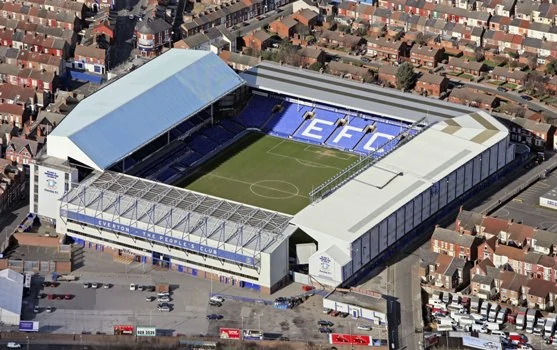Goodison Park is a football stadium in Walton, Liverpool, England, and the home of Premier League club Everton Football Club. The stadium has a seating capacity of 39,414 and was built in 1892. It is located in the Walton area of Liverpool, about two miles north of the city center. Goodison Park has a rich history and has been the home of Everton FC for over 125 years. It is known for its vibrant atmosphere and is one of the oldest and most iconic football grounds in the country.
As Everton has only been out of the top flight for four seasons, Goodison Park has hosted more top-flight games than any other stadium in England (they were relegated in 1930 and 1951). The stadium has also hosted an FA Cup Final and numerous international matches, including a semi-final match at the 1966 World Cup, among others.
| Built In: | 24 August 1892 |
| Capacity: | 39,414 |
| Home Teams: | Everton F.C. |
| Ground Size: | (109.9 yd × 74.4 yd) |
Goodison Park Stadium History
Before Goodison Park
Everton originally played on an open field in the southeast corner of the newly designed Stanley Park (on a site where rivals Liverpool FC considered building a stadium more than a century later). The first official match after being renamed Everton from St. Domingo’s was at Stanley Park, organized on 20 December 1879 with St. Peter’s as the opposition, and admission was free. In 1882, a man named J. Cruit donated a piece of land on Priory Road with necessary facilities for professional clubs but asked the club to vacate their ground after two years because the crowds became too large and noisy.
Everton moved to nearby Anfield Road, a site where proper covered stands were built. Everton played at the Anfield ground from 1884 to 1892. During this time the club turned professional team entering the FA Cup. They became founder members of the Football League and won their first championship on the ground in 1890-1891. Anfield’s capacity grew to over 20,000 and the club hosted an international match with England hosting Ireland. During his time at Anfield, Everton became the first club to introduce goalkeeping into professional football.
In the 1890s, a dispute arose over how the club should be owned and run with John Houlding, Anfield’s majority owner and Everton chairman, at the helm. Houlding disagreed with the club committee who initially disagreed with the full purchase of the land at Anfield from minor land owner Mr. Orrell and it developed into a principled disagreement over how the land was run. club. Two of those disagreements included Houlding wanting Everton to sell only their brewery products during an event and for Everton players to use their public house The Sandon as changing rooms.
The most famous of the disagreements concerns the level of rent increase Everton were asked to pay. In 1889 Everton paid Houlding £100 in rent, which by the 1889–90 season had risen to £250. Everton had to pay for all the works and stands. The dispute escalated to a rent of £370 per year demanded. In the complicated run-up to the club’s split, the rent dispute is too simplistic to be singled out as the root cause. The dispute was compounded by many minor disputed points.
The flash point was a compromise in Houlding’s land purchase contract from Orrell that led to deeper and deeper friction. A strip of land on the Anfield land bordering on adjacent land owned by Mr Orrell, could be used to provide a right-of-way access road for Orrell’s landlocked vacant site. In early 1891, the club erected a stand on this now-proposed road, which also overlapped Orrell’s land, unbeknownst to Everton FC. Committee. In August 1891, Orrell announced his intentions to develop his land next to the football ground, building an access road on the land owned by Houlding and occupied by Everton F.C.
Everton FC stated that they knew nothing of the pact, Houlding claimed that they did. This situation generated a great deal of mistrust that led to friction between Houlding and Everton F.C. Committee. The rift and mistrust between the two parties was on three levels, Houlding’s personal business intentions, politically, and morally. However, the club was faced with the dilemma of whether to destroy the new revenue-generating stand or compensate Orrell.
Houlding’s way of fixing the problem was to propose a limited company with club float allowing the club to buy Houlding and Orrell’s land outright, hoping to raise £12,000. Previous attempts to raise money from the community had failed miserably. This would have meant the club would have to find £6,000 in cash with an additional mortgage of £4,875. The Everton Committee initially accepted Houlding’s proposal in principle, but voted against it in a meeting.
After much negotiation and risky tactics on both sides, Everton vacated Anfield, leaving Houlding with an empty stadium with no one to play in it. As a consequence, Houlding formed his own football club, Liverpool, to settle in the stadium.
The clubs themselves have different versions of the events as to why it happened.
Houlding explained why this situation arose in a Liverpool match program against Cliftonville in April 1893. He noted that he had given Everton a rent-free loan until the club began to make money. If the club had gone bankrupt, he would have lost everything.
Stadium Capacity
Goodison Park Stadium has a seating capacity of 39,414.
Goodison Park Stadium Seating Plan
Notable Events & Records
Not Yet.
Upcoming Events
Not Yet.
Parking
Free parking is available for all tour guests in the Everton One store car park, accessible via Langham Street. The car park is a 5-minute walk from the entrance of Tours (Goodison Road main reception). Free parking will also be available in the Park End car park, accessible via Goodison Road.

